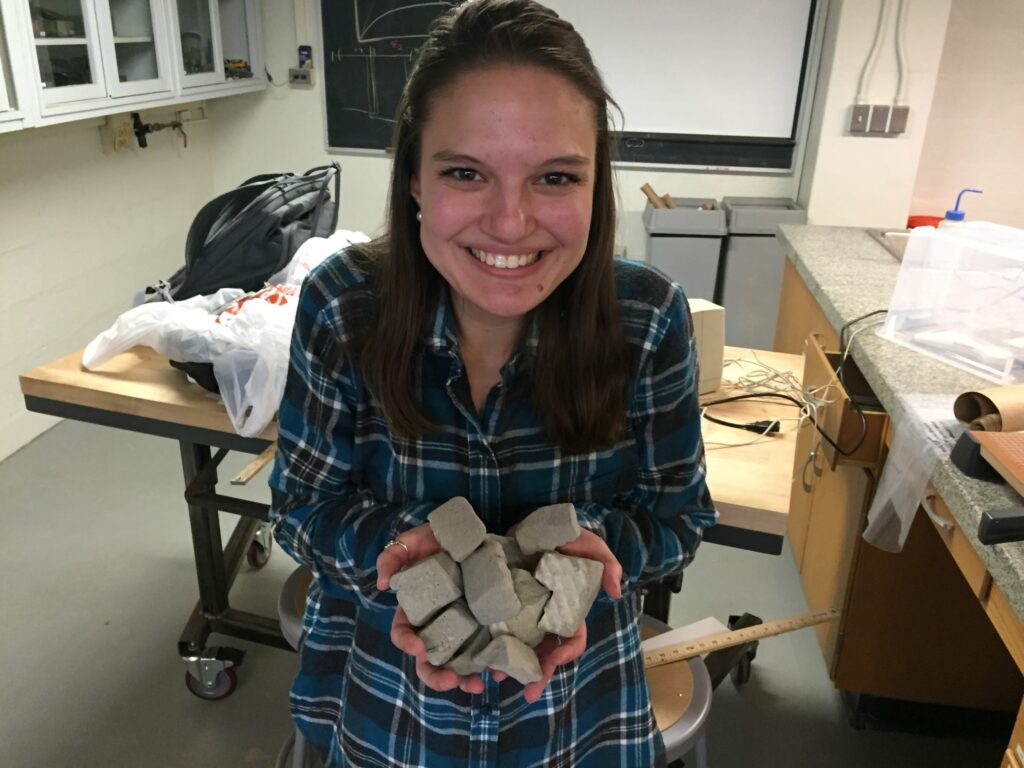By Bryan Hay
It looks and feels like stone, but it’s deceptively feather light.
Made from recycled glass and popular in Europe for decades, foam glass aggregate is a versatile product that can be used in multiple applications: embankments, retaining walls, and building insulation. It’s also used in plaza decks and green roofs; in fact, Rockwell Integrated Sciences Center has the lightweight material on its green roofs.
Now a Lafayette senior working with Michael McGuire, assistant professor of civil and environmental engineering, is studying its strength and durability to help spur wider distribution of the product in the United States.
For her senior honors thesis, Rebecca Blocker ’20 (civil engineering) is conducting strength and density testing on foam glass in conjunction with AeroAggregates of Eddystone, Pa., to better understand how the material can be used as lightweight fill in transportation and building.
 Foam glass is made by crushing recycled glass chips, called cullet, into a fine powder, adding a silicon carbine foaming agent, and heating the powder mixture in a large gas-fired kiln. As the powder travels along a conveyor belt through the kiln, much like a bagel in the toasters at the dining center, the glass softens and foams due to gas bubbles produced by the foaming agent. As the “cake” of foamed glass exits the kiln, it cools rapidly and fractures to baseball-sized pieces that resemble pumice.
Foam glass is made by crushing recycled glass chips, called cullet, into a fine powder, adding a silicon carbine foaming agent, and heating the powder mixture in a large gas-fired kiln. As the powder travels along a conveyor belt through the kiln, much like a bagel in the toasters at the dining center, the glass softens and foams due to gas bubbles produced by the foaming agent. As the “cake” of foamed glass exits the kiln, it cools rapidly and fractures to baseball-sized pieces that resemble pumice.
“And you can hear it. It kind of sounds like Rice Krispies when you put the milk in it, because it goes from a really hot kiln to room temperature,” Blocker says.
“This is a fairly new product in the United States. It’s been used in European countries for some time,” she says. “I was trying to come up with a topic for my thesis, and last summer the company approached Professor McGuire and said they had research that they wanted to get done on their product. It fell into place right at the perfect time.”
Blocker is enjoying learning about the many applications for foam glass.
“It can be used in retaining walls or embankments,” she says. “It’s super lightweight. If you have soft soil, this works well because it reduces the pressure on the soil that causes settlement.”
Foam glass also has insulating properties and might have potential as a concrete aggregate, she adds.
By far the largest application of foamed glass aggregate in the United States is for construction of engineered fills over soft ground, McGuire says.
An understanding of the strength and density of the material is critical for proper engineering and construction quality control. State departments of transportation and other public sector clients are beginning to embrace this material over competing lightweight fill materials, such as expanded polystyrene foam, due to foam glass’s chemical resistance, ease of handling and placement, and use of recycled glass, he notes.
“Rebecca’s work is critical for providing DOTs the evidence that the in-place density of foam glass can be measured reliably,” McGuire says. “Additionally, her work contributes the first known triaxial test measurements of foamed glass shear strength. This information is valuable for engineers designing engineered slopes and walls using foamed glass. Collectively, her work makes a notable contribution to the knowledge and tools we have to improve our infrastructure in a more sustainable way.”
“It’s just really interesting to talk about all of the possibilities,” Blocker says. “There’s definitely a lot more research to be done on this material. It’s challenging, because I’m finding a lot of things that are like, oh, that didn’t quite happen the way we were expecting. I’m learning how to be very adaptable for things that you’re not sure are going to happen.”
